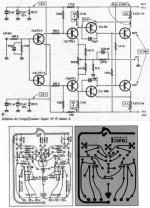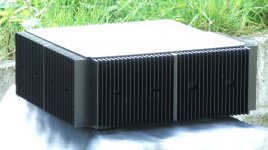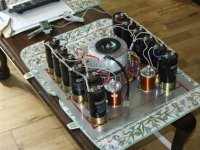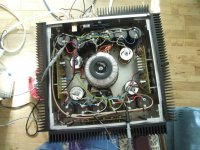KD, I looked at that kit and don't understand how it would offer more learning opportunities than a chip based amp. If "learning along the way" means modifying/changing components on the supplied board, the MyRef threads contain hundreds of those examples.
Please explain if you would. I'm gathering from this thread the point-to point or breadboard approaches are the most useful methods if one wants to really dig in and learn.
Ex: Fremen Beta thread.
Please explain if you would. I'm gathering from this thread the point-to point or breadboard approaches are the most useful methods if one wants to really dig in and learn.
Ex: Fremen Beta thread.
It depends on wether you want a Class A/B Chip Amp or a Class A Discrete Component Amplifier.
The JLH / Hiraga is a VERY GOOD design and "Bang for Buck" you'll be very pleased with the results.
IMO Chip Amps are cheap and cheerful and can be disappointing.
Class A has its drawbacks but these are not sonic. ie you will need a bigger power supply and you will need bigger heatsinks.
Try not to get drawn down the POWER argument at this stage in your learning process. 10W of RMS power is more than enough to annoy the neighbors. 100W is only twice as loud.
I did build an LM3886 Chip-Amp a few years ago to listen to while I was modifying my real Hi-Fi. It was OK but nothing special.
If you realy want to enter the super-league at the bottom end, have a go at an F5. All the boards are available on this site and there are more threads than an old jumper to help you build it.
The JLH / Hiraga is a VERY GOOD design and "Bang for Buck" you'll be very pleased with the results.
IMO Chip Amps are cheap and cheerful and can be disappointing.
Class A has its drawbacks but these are not sonic. ie you will need a bigger power supply and you will need bigger heatsinks.
Try not to get drawn down the POWER argument at this stage in your learning process. 10W of RMS power is more than enough to annoy the neighbors. 100W is only twice as loud.
I did build an LM3886 Chip-Amp a few years ago to listen to while I was modifying my real Hi-Fi. It was OK but nothing special.
If you realy want to enter the super-league at the bottom end, have a go at an F5. All the boards are available on this site and there are more threads than an old jumper to help you build it.
Last edited:
Hi KD . As I said before the only impediment to success when young was my soldering skills . Alas that is true again .
This is what I can find of my JLH inspired 8 W class A amp . 8 Watts was the old definition of hi fi . It becomes an AB amp above that . The parts were ones I had rather than some brilliant plan . This was never intended for showing to others so forgive the way I draw it . I had a better version which I seem to have lost . All graphs are real . 2 x 30 000 uF PSU . 50 uW is an interesting way to measure amps if wondering ( hum / distortion ) . The red 12 R resistor I felt to be critical ( it can be 0R ) . This was built point to point as it saved time mostly . Forgive full size , required for detail . I had an amp based on OPA 604 and complimentary feedback pairs . This one beat it even on measurements . The odd frequencies are due to me substituting a NE5532 op amp for TLO72 in my home-brew oscillator I seem to remember . 5532 is better than I guessed !
Forgot to say . Output capacitor is a precaution . It wasn't required . It was to be made smaller as part of a crossover to a mid range speaker . The final version was from memory - 66dB distortion at any frequency and any level of power ( A or AB using 1 A standing current ) . The strange VAS feedback helped that .

This is what I can find of my JLH inspired 8 W class A amp . 8 Watts was the old definition of hi fi . It becomes an AB amp above that . The parts were ones I had rather than some brilliant plan . This was never intended for showing to others so forgive the way I draw it . I had a better version which I seem to have lost . All graphs are real . 2 x 30 000 uF PSU . 50 uW is an interesting way to measure amps if wondering ( hum / distortion ) . The red 12 R resistor I felt to be critical ( it can be 0R ) . This was built point to point as it saved time mostly . Forgive full size , required for detail . I had an amp based on OPA 604 and complimentary feedback pairs . This one beat it even on measurements . The odd frequencies are due to me substituting a NE5532 op amp for TLO72 in my home-brew oscillator I seem to remember . 5532 is better than I guessed !
Forgot to say . Output capacitor is a precaution . It wasn't required . It was to be made smaller as part of a crossover to a mid range speaker . The final version was from memory - 66dB distortion at any frequency and any level of power ( A or AB using 1 A standing current ) . The strange VAS feedback helped that .

Last edited:
Nigel, I have seen some variations of the JLH and Hiraga Class A amplifiers but I've never seen anything so different to the diagram that you have posted.
This is the classic Hiraga 8W - Unfortunately most of the components are now obsolete.
This is the classic Hiraga 8W - Unfortunately most of the components are now obsolete.
Attachments
Looks like a take on the classic Hiraga Circuit. Do bear in mind that the supplied heatsinks are only for the driver transistors and not the output transistors.
This design always gives pleasing results so you wont be disappointed.
Are you happy with the demands of a Class A amplifier ?
A stereo 10 + 10W Class A amplifier might well need 100W plus of PSU. (Not enormous but it all adds up).
I run a 100 + 100W Class A amplifier, each channel has a 750W PSU.
Have a little snoop around this site http://sound.au.com/tcaas/index.htm
This design always gives pleasing results so you wont be disappointed.
Are you happy with the demands of a Class A amplifier ?
A stereo 10 + 10W Class A amplifier might well need 100W plus of PSU. (Not enormous but it all adds up).
I run a 100 + 100W Class A amplifier, each channel has a 750W PSU.
Have a little snoop around this site http://sound.au.com/tcaas/index.htm
Last edited:
You're not far off the mark.
The 2 Class A amps are actually dissipating about 400W of heat, the remainder of the PSU capacity is for "Headroom", it gives the amps the ability to draw large currents when required.
I won't go into it here but the larger PSU also has lower impedance which helps bass transients.
A 750W PSU is capable of producing 750W - that doesn't mean it is always producing 750W
The 2 Class A amps are actually dissipating about 400W of heat, the remainder of the PSU capacity is for "Headroom", it gives the amps the ability to draw large currents when required.
I won't go into it here but the larger PSU also has lower impedance which helps bass transients.
A 750W PSU is capable of producing 750W - that doesn't mean it is always producing 750W
Start simple and move on up.
That last picture brings it all in focus. Don't want to go more off topic here, but as someone comming from the ~ 68 W LM3886 world, What kind of speakers in terms of efficiency match up well with the 15 - 30w amps of this type?
This little project is EXCELLENT and not fantastically expensive.
Jean Hiraga's Super Class-A Amplifier
Jean Hiraga's Super Class-A Amplifier
No, let's not. Just wanted a quick reference to efficiency. Thanks.
BTW: I often tell the story about a store in Detroit back in the 60s, that had demo about clean power and efficiency. It had a 2 or 3 watt amp and some kind of Bozak or Warfdale monster with multiple 12" drivers. They could easily drive you out of the room.
BTW: I often tell the story about a store in Detroit back in the 60s, that had demo about clean power and efficiency. It had a 2 or 3 watt amp and some kind of Bozak or Warfdale monster with multiple 12" drivers. They could easily drive you out of the room.
Last edited:
- Status
- This old topic is closed. If you want to reopen this topic, contact a moderator using the "Report Post" button.
- Home
- Amplifiers
- Chip Amps
- Basic



